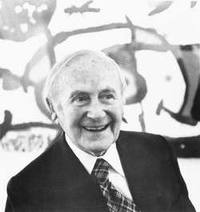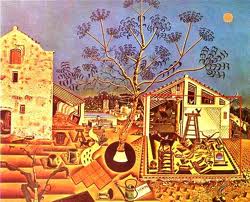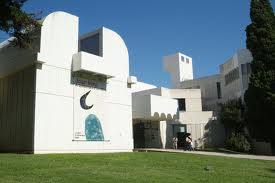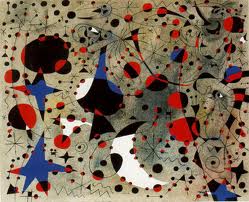Joan Miró Foundation
Where: Parc Montjuïc s/n, 08038, Barcelona
Opening hours: Tuesday to Saturday: October - June, from 10 am to 7 pm, July - September, 10 to 8 pm. Thursday from 10 am to 9.30 pm. Sunday and holidays from 10 am to 2.30 pm. Closed and non holiday Mondays. Visit Joan Miró Foundation's website.
Joan Miró
If you ever spend some time in Barcelona to learn Spanish it is likely you will hear a lot about Joan Miró. Miró is one of Spain's most important artists. He explored many fields of work, among them painting, sculpture, ceramics and engravings. He is considered one of the most remarkable exponents of surrealism.
However he also experimented with other styles such as fauvism, cubism and expressionism until he developed a 'flat' style with a naive air, of which his painting The Farmhouse is his most famous from this period.
Joan Miró was born in Barcelona in 1893. He studied in the Llotja Barcelona School of Fine Arts against his father's wishes. Nevertheless, during his first solo exhibition in 1918 in Barcelona, his paintings were laughed at and even damaged. Miró was completely humiliated, and after this first failure he pursued a career as an accountant. Not for long, though, since he soon suffered a nervous breakdown and went back to art.

Joan Miró joint the Surrealist group in 1924, but, unlike the rest of the members, he stayed out of politics. He lived in different places during the 1930s, including France. However, following the German invasion, he decided to move back to Spain and live under Franco's dictatorship. During the next decade he lived in Barcelona, but he often traveled to Paris to practice printing techniques on which he was experimenting.
During the rest of his life, he continued experimenting with techniques (among them tapestry) and developed the unique style for which he's so well known. In 1956 he decided to leave Barcelona and settle in Mallorca together with his wife, who was from the island. Yet, Miró had a previous tie with Mallorca, as it's where his parents were from and where he spent most of his childhood summers.
The artist died in Mallorca at the age of 90.
Joan Miró Foundation
The Joan Miró Foundation opened its doors to the public in 1975. The origins of the foundation are related to Miró 's first great exhibition in Barcelona in 1968. Many characters from Barcelona's art and culture scene attended the exhibition, and they understood the importance and historical opportunity of having a space of reference for Miró's work.

Following the artist's wishes, the new institution aims to promote the knowledge and dissemination of art in its most contemporary forms. In times where the artistic scene was rather meager, the Joan Miró Foundation injected much vitality into it with a more dynamic concept of the museum, allowing Miró 's work to co-exist with the most diverse artistic manifestations.
The house was designed and built to lodge Miró's collection by Catalan architect Josep Lluís Sert, who was a personal friend of Miró's. When the artist and Sert began thinking about the project of a 'Miró Museum' in its actual location in the 1960s, the first sketches presented by Sert followed the principles of rationalist architecture, with rooms constructed around a central courtyard (a typical characteristic of Mediterranean architecture) and so it was built. The construction also proved flexible and able to house the art of other artists from the 20th and 21st centuries, featuring until today as the paradigm of contemporary architecture. The collection as well as the house are worth the visit.
The Collection
Currently the Joan Miró Foundation collection encompasses more than 14,000 pieces produced by Miró himself, including 217 paintings, 178 sculpture, 4 ceramics and the almost complete collection of Miró's graphic work: some 10,000 sketches and drawings.
Most of the catalogue was donated by the artist himself. Other works of art were supplied from the private collections of Pilar Juncosa (Miró's wife) and Joan Prats (a close friend of the artist's and a driving force behind the creation of the foundation). The collection has been engrossed in later years by donations by close friends and relatives of Miró's.

The collection is classified by chronology, the periods referenced are:
- 1839 - 1919: The beginnings
- 1920 - 1931: Paris and Surrealism
- 1932 - 1939: Plastic concentration and rebellion time
- 1940 - 1955: Configuration of a language
- 1956 - 1983: Sert's workshop. Maturity.
The Joan Miró Foundation also keeps a modest collection of contemporary art, compiled as an homage to the artist one year after his death. This catalogue is made up of donated works of art and long term loans of paintings, sculptures, photographs and objects that belonged to renown artists including Marcel Duchamp, Max Ernst, Henry Moore, Antonio Saura, Balthus and Yves Tanguy among others.
The Joan Miró Foundation also hosts several temporary exhibitions. If you visit Barcelona we suggest you take a look at the foundation's website to find out the current and upcoming activities.



